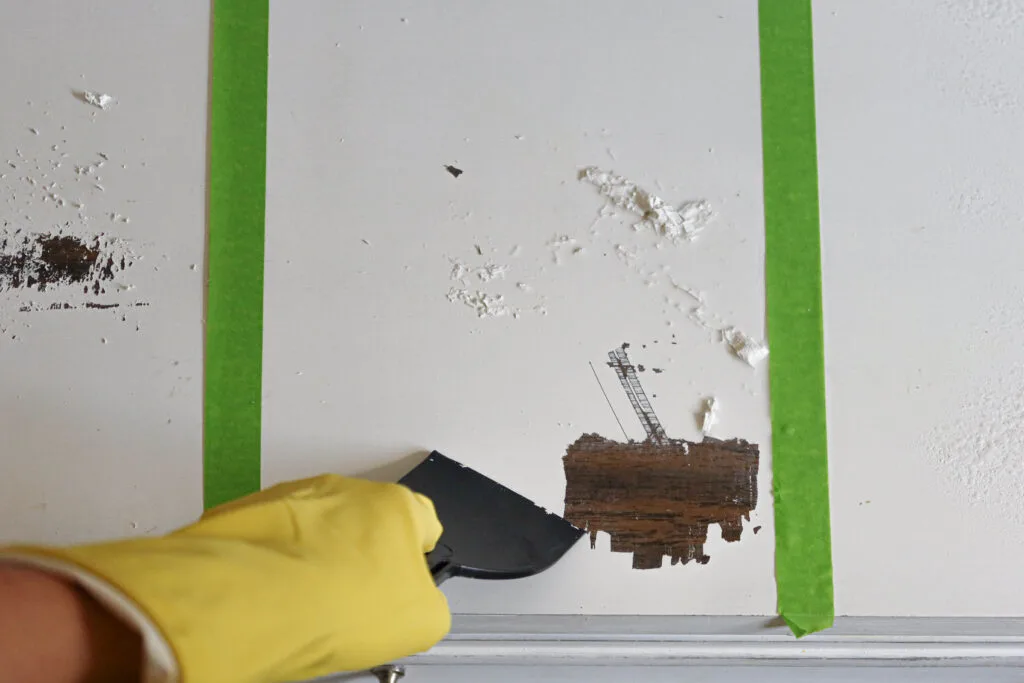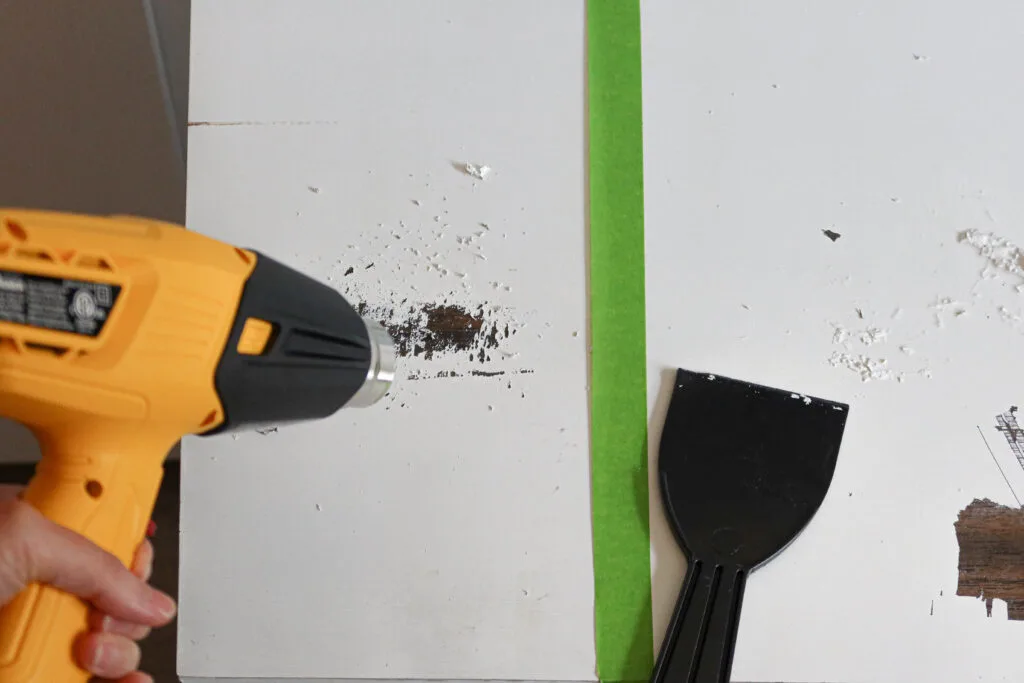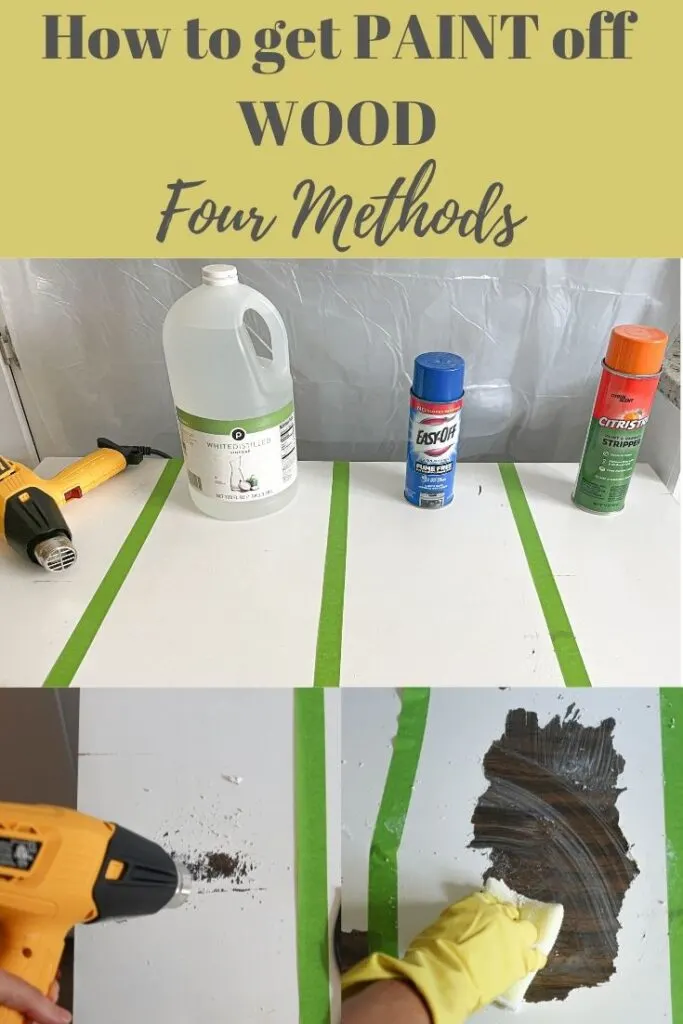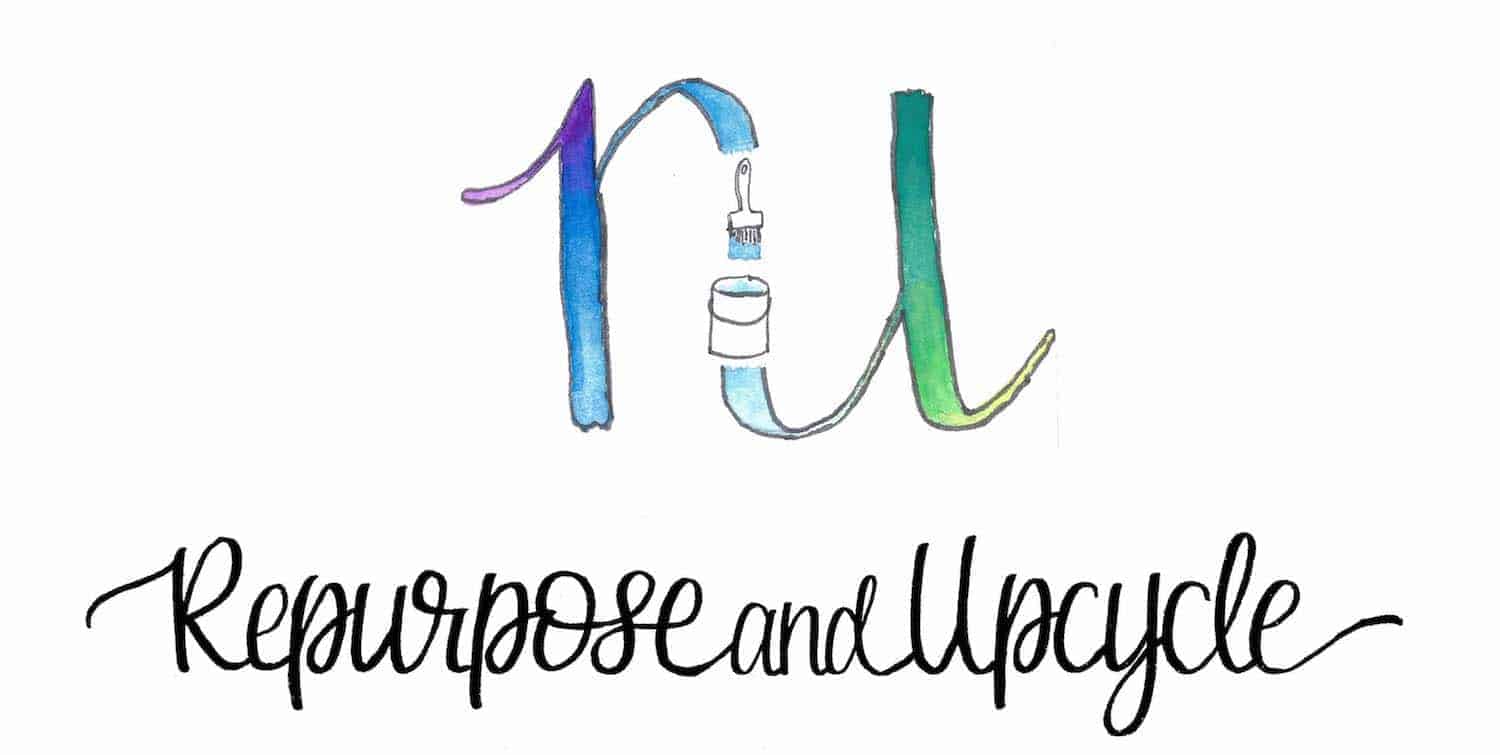Removing old paint from wood is normally a very arduous task. Anyone who has stripped paint knows that it’s not a one step process.
Trying to decide what products to use to strip wood with can also be challenging. Do you use a toxic chemical stripper or a non toxic one? Which ones work the best?
Today I’m doing a little experiment. I’ve always wanted to compare a few paint stripping methods and see which one I like the most. Two of these methods I’ve used before and two I haven’t. You’ll be shocked to see which one works the best (I was!).
Disclosure; this post contains affiliate links. As an Amazon Associate I earn from qualifying purchases. This does not affect the price you pay. This disclosure statement refers to the rest of the amazon links and other affiliate links in this post.
I have an old painted cabinet in our kitchen nook. It was painted with a generic white latex paint. I wanted to strip the top of the cabinet (get rid of the old finish) and leave the base white. I thought it would be fun to experiment with a few different methods to strip paint and see which works best.
The cabinet is mostly solid wood but the top of the cabinet has a laminate veneer type of finish. The top flat surface is what I will be stripping the paint off of today.
Table of Contents
Stripping paint off wood Furniture with four different methods
I used a heat gun, white distilled vinegar, Easy-Off oven cleaner and Citristrip to attempt to remove paint from the top of this wood veneer cabinet. I spent the same amount of time and “elbow grease” with each product trying to remove the paint (about 20 minutes). You can see which method works the best below.
I divided the cabinet top into four sections with painters tape. Each small area was easy to work with a compare to each method.

Removing paint from wood with Citristrip paint stripper
Citristrip paint stripper is my go-to paint remover product. I previously wrote a post on how to strip furniture and I used Citristrip to remove the finish off an old vintage desk. One thing I love about it is that it doesn’t have the harsh fumes that other paint strippers have and it’s just as effective. It did a beautiful job of bringing out the wood grain and gave the old desk a lovely raw wood finish or raw wood look.
How to apply Citristrip to get paint off wood
There are a few ways to apply Citristrip paint stripper. One is by applying a thick, liberal coat of the gel over the surface and let it dry for at least a few hours. The longer you let it sit, the better. The other way you can apply it is with the Aerosol spray can.
I’m sharing how to remove white paint with the Aerosol version of Citristrip. In a nutshell, I sprayed a very liberal amount of Citristrip on the top of the cabinet and let it sit over night. Yes, I let it sit for over 10 hours. In my experience, the longer you let paint stripper work the better.
Tip; try using plastic wrap to wrap the surface where you applied the stripper. This helps loosen the paint even better.
After 10 hours, I used a plastic scraper to scrape away the layers of paint. Was it totally successful? Not 100%. I still had a sticky white residue left on the surface which meant I needed to use mineral spirits and steel wool to clean it and then potentially spray it with Citristrip again and wait a while. Womp womp womp.

Pros and cons of removing paint with Citristrip paint stripper
Pros:
- Breaks the paint down layer by layer
- Easy to apply with the aerosol can
- No harsh fumes but still toxic
- Very effective at removing paint
Cons:
- Takes a while to remove the paint (at least a few hours)
- Leaves a sticky residue that requires mineral spirits, TSP, etc. to remove it
- Be cautious because it will irritate anything it touches including your skin
How to remove paint from wood with white vinegar
Heat a bowl of white distilled vinegar in the microwave for 30 second and liberally apply (with a brush or a rag) a decent amount of vinegar over the surface. Make sure to let the vinegar puddle! After 15 minutes, use a plastic scraper or putty knife to remove the paint.
Is vinegar successful at removing paint?
Vinegar is successful at removing small areas of paint, but it’s not entirely effective at stripping a large surface of paint. Vinegar is a great non toxic method to remove paint drips and paint splatters. It’s not recommended to remove paint off an entire piece of furniture.
Would I recommend Vinegar for removing paint from wood?
Honestly, no. I’ve tried it twice and I don’t think I will use it again. That being said, I will probably use it sparingly to remove paint drips and it might be a good non toxic option for removing products like acrylic paint.
Pros and cons of removing paint with vinegar
Pros:
- Non-toxic, natural alternative to using harsh chemicals
- Household item that is readily available
- Won’t damage any other surface
Cons:
- Not very effective at removing paint from large areas
- Takes patience and a lot of scraping to remove paint
- Might take a few different applications to remove all the paint

How to remove paint from wood with Easy-Off oven cleaner method
Easy off oven cleaner is a fairly new technique that works to remove paint just like it does dirt and grime in your oven. It loosens the paint from the surface so you can easily wipe it away.
The instructions said to spray a liberal amount of cleaner on the surface and let it sit for over an hour. That is what I did!
Once an hour had passed I used a wet sponge and warm water to wipe the surface. To my utter surprise, the paint wiped away with no problems! I didn’t even have to use mineral spirits or TSP to clean the surface because it’s already clean!
I couldn’t believe my eyes! I was really thinking this wasn’t going to work well at pulling up the paint. I was wrong!

Pros and cons of removing paint with Easy-Off oven cleaner (Do I dare say furniture stripper?)
Pros:
- Easy to use. Spray it on and wait an hour then wipe away the paint
- Doesn’t create a sticky residue like other paint removal methods
- Wipes away easily with a damp sponge
- Cleans the surface as it removes paint
- Quickest way to remove paint from wood
Cons:
- Not intended to be used to remove paint
- Toxic so needs to be used in a well ventilated area with protective gear
How to remove paint from wood with a heat gun
SAFETY TIP: Make sure you are not removing lead paint! The heat gun will vaporize toxic fumes if you do, so be 100% sure it’s free of any leaded paint.
While holding the heat gun about 1 inch away from the surface, move it around in circles or back and forth slowly. After a minute (or a few seconds depending on the paint), use a paint scraper to see if you can scrape the paint.
The heat gun acts to melt away the paint (or separate it from the surface) allowing you to scrape it away.
For me, I had to move the heat gun for a few minutes before it allowed me to scrape any paint away.
As long as you are moving the heat gun around and not staying in one place for long, you shouldn’t have to worry about burning the wood.
This method for removing paint is the most time consuming. It can also be the most messy, especially if the paint doesn’t pull up in large chunks.
Can you use a hairdryer to remove paint from wood?
A hairdryer will work the same way a heat gun will, it just won’t get as hot. There are a few different schools of thought on this. Some experts say it’s best to use a hairdryer (and even a heat gun) on a low heat and low speed setting. The reason for this is that it helps loosen the paint slowly and prevents it from “melting.”
From a personal experience, I’ve never had any luck with using a hairdryer or a heat gun on a low setting and speed to remove paint. I feel like there is a “sweet spot” to creating enough heat to loosen the paint while not melting it. Unfortunately, I haven’t been successful in finding this with a heat gun OR a hairdryer. Maybe I’m just impatient.
Honestly though, why take hours to remove paint from flat surfaces with a heat gun when there are quicker methods? This is why I would suggest using this method for small areas only.
Pros and cons of removing paint with a heat gun
Pros:
- No harsh chemicals
- Can loosen latex paint effectively if set at the right temperature
Cons:
- Can possibly melt the surface if you’re not careful
- Leaves a sticky melted residue (melted paint) if you aren’t careful with the heat settings
- Takes time and patience

What is the easiest way to remove paint from wood?
All four of these methods remove paint from wood furniture. They all just work differently.
In a nutshell, I wouldn’t suggest using the heat gun method or the vinegar method to strip a large surface area or an entire piece of wood. I would use these two methods for new paint drips, paint splatters and small areas.
I would use the oven cleaner and paint stripper to get paint off an entire piece of wood or to strip a furniture piece.
Update: Since this post was written I’ve stumbled on a new favorite (NON TOXIC, ALL NATURAL) paint stripping product. Check out QCS by Stripwell with my full review. Y’all this product is a game changer.
If you want to see more about stripping a piece of furniture with Easy Off Oven Cleaner check out this post. Spoiler alert; it wasn’t as successful as I thought it would be.

The Best Paint Stripper:
Overall, the Easy-Off oven cleaner worked the best at removing paint from wood. As you can tell with the pros and cons list; I had an endless amount of pros and only a few cons.
Have you ever used any of these methods before? I’m always open to suggestions and new ideas of how to strip paint off wood. See more painting and refinishing tips here!
Thanks for following along!
Lindsey**

Hi! I wanted to suggest a con to your easy-off oven cleaner method. It’s definitely the best and easiest for beginners but.. per can it can be slightly pricey compared to say, citristrip or vinegar, but it is extremely flammable. When used on wood, the wood absorbs the foam and chemicals. You can never fully get the oven cleaner, out of the wood. When sealed, it’s safer, but never gone. I will say for regular furniture, it’s not a huge risk. But for kitchen cabinets it can be bad.
Thank you for your input! This is definitely good to know. I guess there is a reason it’s for hard metal surfaces and not wood!
Do you feel like you need heat (like the sun heat) for the easy off?
No heat or sun needed!
Very risky to use a heat gun! If it is leaded paint, you would breath the lead vapor released by the heat.
You are correct! But I know it wasn’t lead paint.
Easy Off…who would have thot. I’ve always used a harsh paint stripper that requires thick rubber gloves and ventilation. Thank you!